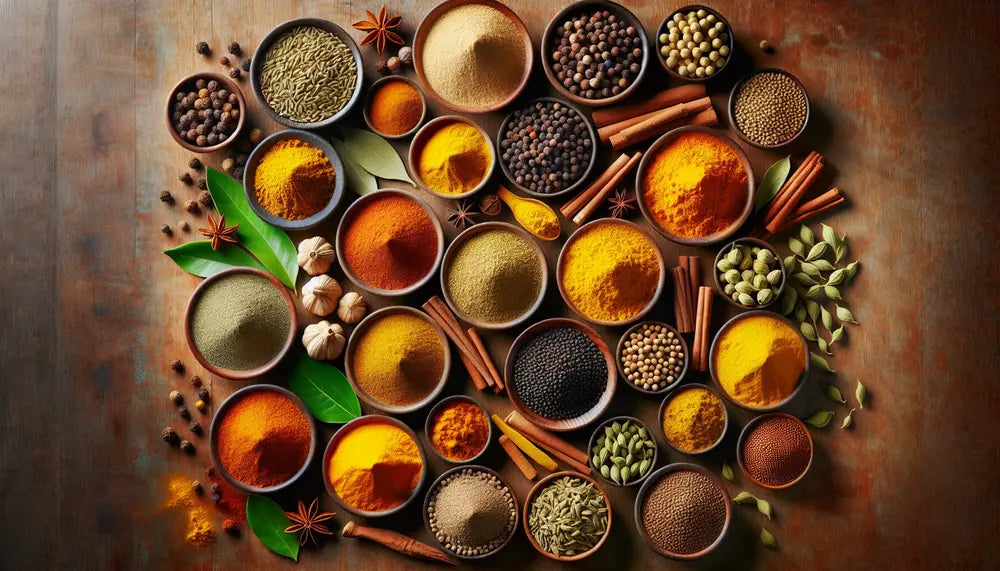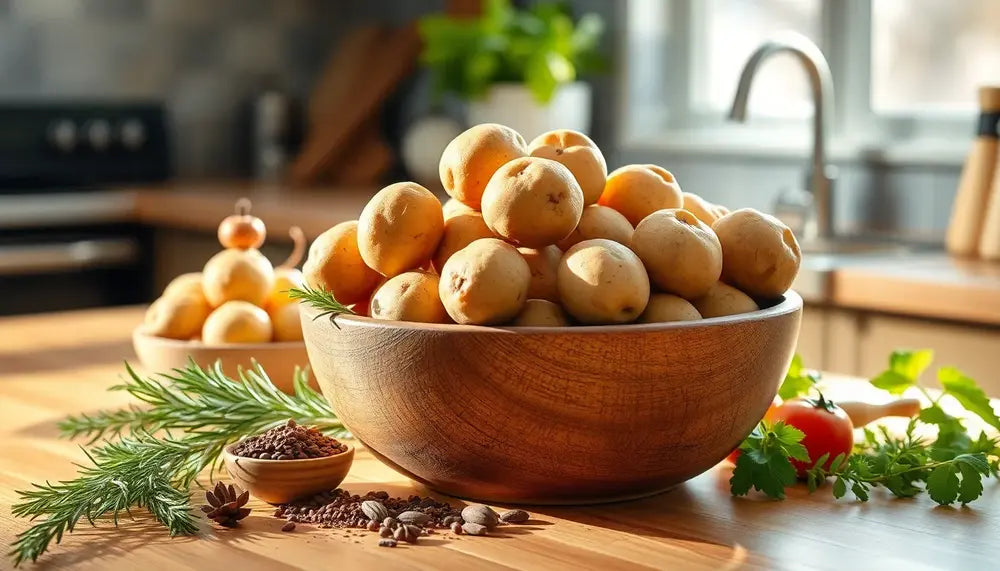Introduction
Indian cuisine is famous for its aromatic and a variety of spices. These spices not only give the dishes flavor, but also color and a distinctive aroma. In this article, we explore the fascinating world of Indian spices, their uses in cooking and their health benefits. Whether you are a beginner or an experienced chef, you will find valuable tips and information to expand your culinary skills.
The Importance of Indian Spices
Indian spices play a central role in Indian cuisine. They are crucial not only for taste, but also for the country's cultural identity. Each region in India has its own unique spice blends and recipes that are passed down from generation to generation.
Taste and aroma
Spices like Turmeric, Coriander and Cumin are the cornerstone of many Indian dishes. They give the dishes their characteristic aromas and make every dish a taste experience.
Cultural significance
In India, spices are often associated with spiritual and cultural practices. Certain spices have symbolic meanings and are used in festivals and religious ceremonies. For example, turmeric is a symbol of purity and prosperity.
Variety of Indian spices
The variety of Indian spices is impressive. There are hundreds of different spices, each with their own unique properties. This variety allows chefs to create a wide range of flavors, from sweet to spicy, mild to intense.
Economic importance
The spice trade has a long history in India. Centuries ago, India was an important exporter of spices such as pepper, cinnamon and cloves. Even today, Indian spices are still in demand worldwide and contribute to the country's economy.
Popular Indian spices and their uses
Turmeric
Turmeric, also as Turmeric is one of the most famous Indian spices. It is valued for its bright yellow color and mildly spicy taste. Turmeric is a main ingredient in curry powder and gives a golden color to many dishes, such as dal (lentil dish) or rice dishes.
Coriander
Coriander is an important part of Indian cuisine both as a seed and as a fresh herb. The seeds have a slightly sweet taste with a hint of lemon. They are often roasted and ground to add flavor to curries, chutneys and marinades. The fresh coriander greens are often used as a garnish.
Cumin
Cumin, too Cumin called, has a warm, earthy taste with a slightly bitter undertone. It is often fried in oil to release its full flavor before other ingredients are added. Cumin is an indispensable ingredient in masalas (spice mixes), curries and tandoori dishes.
Garam masala
Garam masala is a popular Indian spice mixture that consists of various spices such as cardamom, cinnamon, cloves and pepper. The name literally means "hot mixture" as these spices are said to generate body heat. Garam masala is often added at the end of cooking to give dishes an intense flavor.
These spices are just a few examples of the rich diversity of Indian cuisine. Each spice has its own unique use and helps make the dishes so varied and flavorful.
- Turmeric
Turmeric is a true miracle spice in Indian cuisine. In addition to its use as a spice, it also has many health benefits. It contains the active ingredient Curcumin, which has anti-inflammatory and antioxidant effects.
Use in the kitchen
- Curry dishes: Turmeric is a main ingredient in many curry recipes and gives them their typical yellow color.
- Rice dishes: A little turmeric in the rice provides an attractive color and a light aroma.
- Sauces and soups: Turmeric can add additional flavor and health benefits to sauces and soups.
Health Benefits
Turmeric is traditionally used in Ayurvedic medicine. It helps with digestive problems, relieves joint pain and promotes overall health. A well-known drink is "Golden Milk", a mixture of milk, turmeric and other spices that is drunk before going to bed.
Storage tips
Turmeric should be stored in a cool, dry place to preserve its freshness. Ground turmeric loses intensity over time, so it is advisable to use it within six months.
With its wide range of uses and health benefits, turmeric is an essential spice in every cuisine, especially Indian cuisine.
- Coriander
Coriander is a versatile spice used in Indian cuisine as both a seed and a fresh herb. It has a mild, citrusy flavor that adds a refreshing touch to many dishes.
Use in the kitchen
- Curry dishes: Ground coriander seeds are an important ingredient in many curries and masalas.
- Chutneys and dips: Fresh coriander is often used in chutneys and dips Raita used.
- Salads: The fresh herb is often used as a garnish for salads and other cold dishes.
Health Benefits
Coriander contains many vitamins and minerals. It supports digestion and has anti-inflammatory properties. Coriander also plays a role in detoxifying the body as it helps remove heavy metals from the body.
Storage tips
Coriander seeds should be stored in an airtight container in a cool, dry place. Fresh coriander can be stored in the refrigerator, preferably wrapped in a damp cloth or placed in a glass of water like bouquets of flowers.
Coriander not only brings flavor and aroma to your dishes, but also contributes to health. A real all-rounder in the kitchen!
- Cumin
Cumin, or even Cumin called, is an indispensable spice in Indian cuisine. It is characterized by its warm, earthy taste and slightly bitter undertone.
Use in the kitchen
- Masalas: Cumin is an essential ingredient in many Indian spice blends such as garam masala.
- Curry dishes: Cumin roasted in oil forms the basis for many curries and sauces.
- Bread and pastries: Cumin seeds are often sprinkled on breads and pastries to add additional flavor.
Health Benefits
Cumin is rich in iron and supports digestion. It also has anti-inflammatory and antioxidant effects. It is also traditionally used to relieve flatulence and digestive problems.
Storage tips
Cumin seeds should be stored in an airtight container in a cool, dry place. Ground cumin quickly loses its aroma, so it is recommended to grind the seeds fresh if necessary.
Cumin not only adds depth and complexity to your dishes, but also contributes to a healthy diet. A real must for Indian cuisine lovers!
- Garam Masala
Garam masala is a famous Indian spice mix that consists of a variety of spices. The name means “hot mixture” because the spices it contains have a warming effect on the body.
Use in the kitchen
- Curry dishes: Garam masala is often added at the end of cooking to give dishes an intense flavor.
- Tandoori dishes: It is an important ingredient in marinades for tandoori chicken and other grilled dishes.
- Sauces and stews: Garam masala can also add depth and complexity to sauces and stews.
Ingredients of Garam Masala
The exact composition may vary, but typical ingredients include:
- cardamom
- Cinnamon
- clove seeds
- Peppercorns
- Cumin
Health Benefits
By combining different spices, Garam Masala offers many health benefits. It can promote digestion, have an anti-inflammatory effect and strengthen the immune system. The individual spices each contribute their own positive properties.
Storage tips
Garam masala should be stored in an airtight container in a cool, dry place. To get the full flavor, it is advisable to use the mixture within six months.
With its unique blend of flavors and health benefits, Garam Masala is an essential spice in Indian cuisine. It brings warmth and depth to any dish and enriches your culinary creations.
Health Benefits of Indian Spices
Indian spices are popular not only for their taste but also for their numerous health benefits. Many of these spices have been used in traditional medicine for centuries.
Antioxidant properties
Lots of Indian spices, like Turmeric and Cumin, contain powerful antioxidants. These help to neutralize free radicals in the body and can thus reduce the risk of chronic diseases.
Anti-inflammatory effect
Spices like Turmeric and Garam masala have anti-inflammatory properties. They can help relieve inflammation and pain and are particularly useful for conditions such as arthritis.
Digestive
Coriander and Cumin are known to promote digestion. They can relieve flatulence and indigestion and support healthy intestinal function.
Strengthening the immune system
Turmeric and many other Indian spices can strengthen the immune system. They help the body fight off infections and improve overall health.
Lowering blood sugar levels
Some spices, such as Cinnamon, can help regulate blood sugar levels. This is particularly beneficial for people with diabetes or insulin resistance.
Table: Health benefits of selected Indian spices
| Spice | Main advantage(s) |
|---|---|
| Turmeric | Anti-inflammatory, antioxidant, immune-boosting |
| Coriander | Digestive, detoxifying |
| Cumin | Digestive, rich in iron |
| Cinnamon | Lowering blood sugar levels, antioxidant |
| Clove seeds (in garam masala) | Aromatherapeutic, anti-inflammatory |
Incorporating these spices into your daily diet can not only bring you culinary enjoyment, but also support your health in many ways.
How to store Indian spices properly
Proper storage of Indian spices is crucial to preserving their aroma and freshness. Here are some tips on how to best store your spices.
Store in a cool and dry place
Spices should be stored in a cool, dry place. Humidity and heat can affect the quality and taste of the spices. A pantry or pantry is ideal.
Use airtight containers
Store your spices in airtight containers to protect them from air and moisture. Glass containers with tight-fitting lids or special spice jars are particularly suitable.
Avoid direct sunlight
Do not store your spices in direct sunlight. UV rays can break down the essential oils in the spices and thus reduce the aroma. Dark containers or cupboards are therefore preferable.
Prefer whole seeds
Whole spice seeds retain their flavor longer than ground spices. If necessary, freshly grind the seeds to retain the full flavor. This is especially true for spices like cumin and coriander.
Check regularly
Check your spices regularly for freshness and aroma. When a spice loses its smell or taste, it's time to replace it. A rule of thumb: Ground spices should be used within six months, whole seeds within a year.
| Spice | Storage period (unopened) | Storage period (opened) |
|---|---|---|
| Turmeric (ground) | 12 months | 6 months |
| Coriander seeds (whole) | 24 months | 12 months |
| Cumin (whole) | 24 months | 12 months |
| Garam Masala (mixed) | 12 months | 6 months |
By storing them correctly, you can ensure that your Indian spices stay fresh for a long time and develop their full flavor.
Conclusion
Indian spices offer an impressive variety of flavors and health benefits. From Turmeric about Coriander up to Garam masala – each spice brings its own unique properties that can enrich your dishes.
Proper storage is crucial to preserving the full flavor and freshness of these spices. By using airtight containers, avoiding moisture and direct sunlight, and grinding whole seeds when necessary, you can ensure your spices last a long time.
In addition, Indian spices offer numerous health benefits. They promote digestion, have anti-inflammatory and antioxidant effects and can even strengthen the immune system. Incorporating these spices into your daily diet can not only delight your taste buds, but also improve your well-being.
By exploring the rich tradition of Indian cuisine and incorporating these aromatic spices into your own recipes, you can explore new flavor horizons while reaping the health benefits. Be inspired and enjoy the diversity of Indian cuisine!
Frequently asked questions about Indian spices
What are some of the most famous Indian spices?
Some of the most famous Indian spices are turmeric, coriander, cumin and garam masala. These spices give dishes unique flavors and colors.
What is the best way to store Indian spices?
Spices should be stored in a cool, dry place in airtight containers. Direct sunlight should be avoided to preserve aroma and freshness.
What are the health benefits of Indian spices?
Indian spices have many health benefits. They have anti-inflammatory, antioxidant effects and promote digestion. Turmeric, for example, can strengthen the immune system and reduce inflammation.
How is Garam Masala used in cooking?
Garam masala is often added to dishes at the end of cooking to give them an intense flavor. It is also used in marinades for tandoori dishes and in sauces.
Which regions in India are known for their special spices?
Different regions in India are known for their special spice blends and recipes. For example, Kerala is famous for its pepper varieties and Hyderabad for its hot chillies.





Share:
Allspice: The spice with that certain something
Paprika: The versatile spice for your kitchen